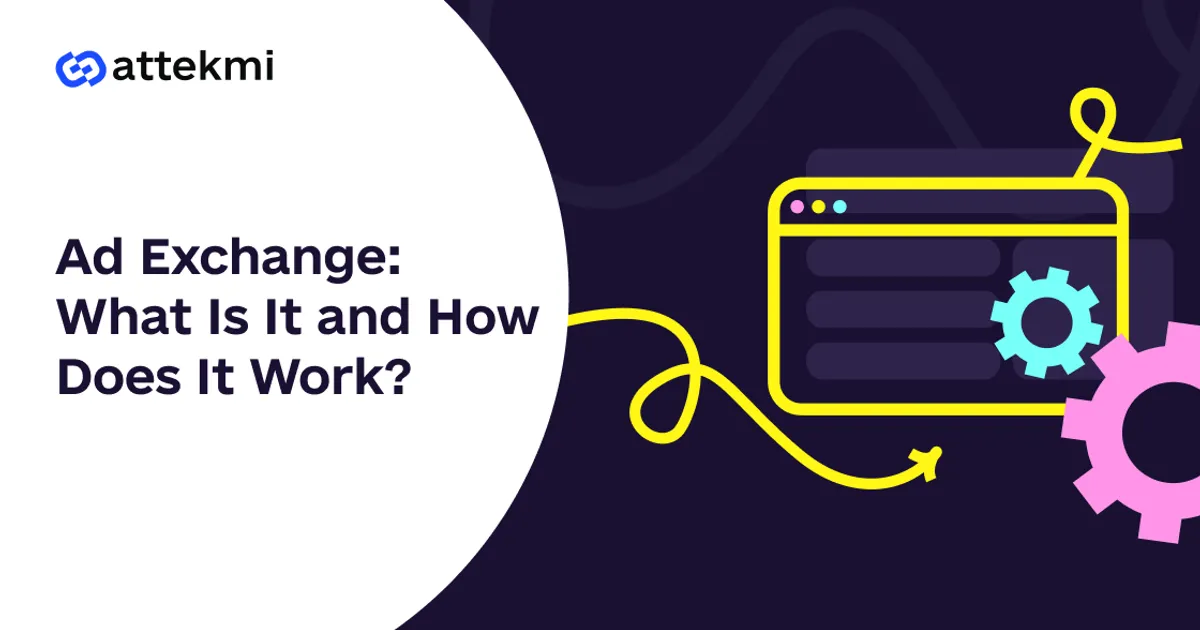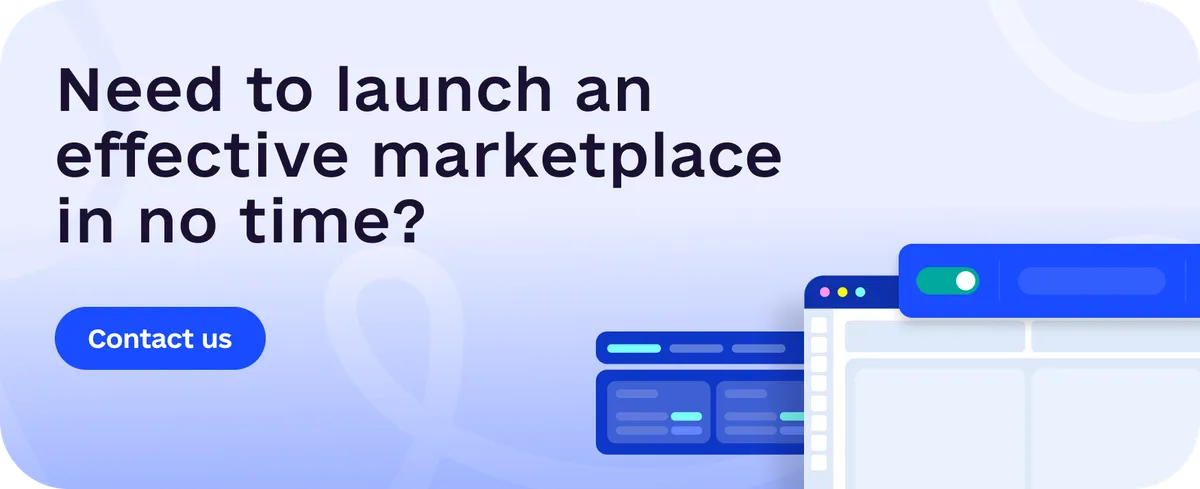Investments in programmatic advertising keep growing, as this technology offers precise targeting, access to a range of environments, and an opportunity to streamline the process of media buying and selling.
To join the programmatic ecosystem, advertisers need to use demand-side platforms (DSPs). In turn, publishers rely on supply-side platforms (SSPs). But how do these solutions connect with each other? This is what an ad exchange is responsible for.
But what is an ad exchange? How does it work? What are the different types of ad exchange platforms?
Since 2018, Attekmi has been empowering businesses to launch their own profitable marketplaces within the shortest time possible. Relying on our extensive knowledge of ad exchanges and their principles of work, we have prepared this guide to answer all the questions mentioned above, and even more. Keep reading to learn more about the programmatic industry and gain actionable insights.
Key Takeaways
An ad exchange is a digital marketplace connecting demand and supply-side platforms and enabling programmatic media buying and selling.
Ad exchanges are often confused with ad networks, but they are not the same thing. An ad exchange is an integral part of the real-time bidding process, while a network sells inventory on behalf of publishers and may also use an advertising exchange.
For both advertisers and publishers, the key benefits of using an ad exchange are the access to a wide pool of opportunities and an accelerated process of media buying and selling.
Getting your own ad exchange solution is a way to get ultimate control over advertising operations and earn from media trading.
Attekmi offers a range of ad exchange platforms that is able to meet any needs: from an entry-level solution to a fully customizable option.
What is an ad exchange?
An ad exchange is a digital marketplace that allows advertisers and publishers to connect with each other and, therefore, enables the process of buying and selling digital inventory. It works as an intermediary between supply and demand-side platforms, and the inventory is usually sold via real-time auctions. Additionally, exchanges send commands to servers when the winner is defined.
An open programmatic ad exchange platform allows all media buyers to take part in the auction. In turn, private exchanges accept only advertisers selected by a publisher.

Ad exchange vs ad network: key differences
Note that an ad exchange is not the same thing as an ad network, and understanding this difference is crucial in terms of navigating the programmatic ecosystem effectively. Networks buy ad space from publishers and then sell it to marketers – they act as additional intermediaries. For real-time bidding, ad networks are not essential, only optional. In turn, an ad exchange is an integral component when it comes to real-time or header bidding auctions.
While using ad networks may offer some benefits for publishers, reducing the number of intermediaries leads to greater transparency, which contributes to a healthier programmatic environment. The table below clarifies the difference between ad exchange vs ad network in detail.
Ad Exchange | Ad Network | |
What is it? | A digital marketplace connecting SSPs and DSPs | An intermediary selling inventory on behalf of publishers |
Level of control for publishers | High, as publishers set everything up on their own | Limited |
Level of transparency | May vary, but higher than in the case of ad networks | Low |
Ad inventory type | Diverse ad formats | Usually, specific inventory, ads are often purchased in bulk |
Optimization opportunities | Optimization can be done in real time | Takes time |
How an ad exchange works: RTB, auction types, and process
You already have some basic knowledge of how an ad exchange platform works. Now, let’s take a closer look at its mechanisms.
Real-time bidding (RTB) explained
So, getting back to RTB, an ad exchange allows selling ad inventory via instant auctions. After a user enters a website or an app and an impression becomes available, this data is sent to a supply-side platform where a publisher sets the bid floor. Then, the request is delivered to the demand-side platform, and the RTB auction takes place on an ad exchange. The highest bid wins, and the ad is delivered to the user. The whole process takes only a couple of seconds.
For marketers, real-time bidding enables more precise targeting so they can advertise more effectively. Since they can purchase more relevant inventory, the ads are delivered exactly to those users who are most likely to be interested in this content. This way, advertisements have higher ROI.
For publishers, RTB auctions allow them to drive revenue and increase their fill rates. Besides, since RTB allows more effective targeting and higher content relevance, the experience of their website visitors and app users is not affected.
Auction types
In RTB, there are two main auction types: first-price and second-price.
First-price auctions: the highest bid wins, and an advertiser pays the exact bid amount.
Second-price auctions: the highest bid wins, and an advertiser pays $0.01 more than the second highest bid.
First-price auctions are beneficial for both publishers and advertisers. Thus, it becomes easier for marketers to outline their financial strategies. In turn, publishers drive higher revenue, while the auction itself is more transparent. During second-price auctions, marketers may place unnaturally high bids since they know that they will still pay less if they win.
However, second-price auctions still allow advertisers to prevent overspending and collect insights regarding competition, which can help optimize future bids. As for publishers, they may earn less, while it also becomes more difficult for them to understand the real value of their inventory. At the same time, they may experience higher demand for the ad space since advertisers know that they will not overpay.
Key players and their roles
An ad exchange is not the only participant of the programmatic ecosystem, so let’s review other players to provide you with a better understanding of how everything works:
Supply-side platforms (SSPs): software used by publishers to manage their ad inventory, sell it, and analyze the results to optimize the selling process and maximize income.
Demand-side platforms (DSPs): software used by advertisers for programmatic ad buying. Via DSPs, marketers set up their campaigns and join the auctions when a relevant impression becomes available. Basically, DSPs are the reverse side of SSPs.
Ad servers: software responsible for delivering and storing digital ads. After the winning bid is identified, a server receives a notification from an advertising exchange, and the ad is sent to the publisher.
Data management platforms (DMPs): platforms that collect, arrange, analyze, and store customer data. They can be integrated with DSPs, SSPs, and exchanges to ensure relevant ad distribution.
Benefits of using an ad exchange for publishers and advertisers
Using an ad exchange implies benefits for both marketers and media owners. Let’s review them in detail.
Benefits for publishers: better monetization and control
For publishers, the advantages are as follows:
Access to a wide pool of advertisers: While direct sales and even ad networks may imply limited reach, an ad exchange allows publishers to connect with a large number of media buyers.
Effective monetization: Publishers set floor prices and can monetize diverse types of inventory efficiently, both via open and private exchanges.
Enhanced control: Media owners can connect with the most relevant advertisers, block specific marketers or content categories to improve brand safety, etc.
Streamlined processes: It takes less than a second for an auction to be completed on an ad exchange, which is much faster than negotiating direct deals.
Benefits for advertisers: precision targeting and budget efficiency
For marketers, the processes are streamlined as well. Besides, they also benefit from access to a wide pool of publishers and formats and environments, including connected TV (CTV), digital out-of-home (DOOH), and others. However, there are more advantages of using an ad exchange to consider:
Accurate targeting: By applying targeting and filtering settings on their demand-side platforms, advertisers can compete for relevant inventory via an ad exchange and reach exactly those users who are most likely to convert.
Budget optimization: By applying DSP functionalities, marketers can prevent overspending on an ad exchange and bid only for relevant impressions.
Real-time campaign optimization: Campaigns can be adjusted promptly to ensure greater performance.
Access to premium inventory: By competing on a private ad exchange, advertisers get an opportunity to purchase exclusive inventory, which also contributes to brand safety.
Expert advice: key considerations when using ad exchanges
Programmatic technology, including digital ad exchanges, is a powerful ally for advertisers and publishers. Artificial intelligence in ad exchanges now plays a key role in enhancing efficiency and precision. However, it must be used in the right way, so here are several expert opinions to keep in mind.
Human oversight is still required
Even after setting up all the parameters, it is still essential for marketers and publishers to keep an eye on the process. Yes, auctions are instant, and everything happens automatically, but not everything should be done by AI. For instance, publishers and advertisers need to continuously analyze the results on their own to make timely decisions regarding optimization, while owners of ad exchanges should also look at what is happening on their platforms and integrate traffic and demand scanners for their partners. Ad fraud remains a serious threat in the programmatic environment, and, from our experience, integrating scanners can significantly minimize the risks.
Targeting matters
Accurate targeting has always been important in digital advertising, and the programmatic approach is no exception. To reach their audiences via an ad exchange, advertisers should set up as many targeting settings on their DSPs as possible. This will allow them to reach their audiences effectively and drive conversions.
In turn, owners of ad exchange platforms should use targeting settings to match the right demand with the right supply. Precise targeting enables you to ensure effective media trading, which positively affects your income. For instance, on Attekmi’s solutions, targeting settings include traffic type, ad format, geo, connection type, price limit, and many more.
Third-party cookies are fading away
The effective performance of an exchange heavily relies on the data provided by advertisers via DSPs. Previously, a lot of data could be collected via third-party cookies, and this opportunity is still here even though it is limited. However, the end of the cookie era is coming, so marketers should start switching to first-party data. There is no time to hesitate — those advertisers who already rely on first-party data will have a strong competitive advantage when cookies are fully eliminated.
It is also crucial to remain compliant with privacy-related regulations and standards – in response to growing user concerns about privacy, they are getting stricter. Attekmi’s ad exchange solutions are compliant with GDPR, TCF 2.0, CCPA, and COPPA, and support the creation of ads.txt and sellers.json files to ensure greater transparency.
5 key factors to consider when choosing an ad exchange
Why is ad exchange important? Apart from automating the auction process, it improves brand safety for both publishers and marketers. Additionally, advertisers benefit from better control over their budgets, while publishers can reach more effective inventory monetization. But how to choose the best ad exchange? Here are some recommendations to follow.
Keep your goals in mind
As you remember, there are different types of advertising exchanges: open, private, etc. Therefore, the first step to take is to identify your goals. For instance, if you, as a publisher, want to access a wider pool of marketers, preferring an open exchange may be the right decision. In turn, if you offer premium ad inventory, choosing a private marketplace is likely to be the best choice. For advertisers, this recommendation works as well.
Decide on the ad formats
Exchanges may support different ad formats, so it is essential for advertisers to decide what campaigns they are going to launch. The same applies to publishers — they should understand what inventory they can offer. For instance, these can be display, native, or audio ads. Deciding on the required formats is the way to limit the list of potential options and simplify the choice. At the same time, keep in mind that you may want to experiment with other formats in the future, so prefer a solution that supports not only the required options but also the additional ones.
Aim for transparency
The right ad exchange should provide information regarding where the ads appear, as well as about the associated transaction costs and potential fees.
Check the quality of the inventory
For advertisers, it is also crucial to check the quality of ad inventory available on an ad exchange. Choosing a platform that works with reputable websites that have engaged audiences will lead to more effective ad placement and higher ROI. This also helps reduce the risks of ad fraud.
Explore targeting and security features
Advanced targeting capabilities ensure greater relevance of the ads, which is important for both marketers and publishers. Besides, the solution should be equipped with security functionalities for detecting and blocking fraudulent activities, filtering out risky inventory, and so on.
Note that getting your own ad exchange solution is a way to gain greater control over your processes. As an advertiser, you can use it to match your DSP with the most relevant supply. In turn, publishers can connect their SSPs with the most appropriate and profitable demand.
Launch a powerful ad exchange platform with Attekmi
Developing an ad exchange solution from scratch can be an expensive and time-consuming process. However, there is a way to get to the market much faster while minimizing the expenses. We offer an extensive variety of ad exchange platforms for any taste:
AdEx Basic: An entry-level solution with basic functionalities.
AdEx Plus: An enhanced version of AdEx Basic, with additional features and certain scalability opportunities.
AdEx Enterprise: A solution with advanced functionality and an ultimately scalable nature.
White Label Ad Exchange: A custom ad exchange platform that gets tailored to your needs, from UI personalization to on-request feature development.
Thus, with our ad exchange services and solutions, Mobupps achieved 371% ROI and 207% revenue growth, while StreamKey reached 1637% ROI and doubled the revenue.
And that is not all. We are your trusted partner in any AdTech matter, so we also offer the following services:
Custom AdTech development: We can create ad exchange software, a demand-side platform, a data management platform, etc. We are here to bring your unique AdTech project to life.
Ad Ops outstaffing: We can train an expert specifically for your business so that you can focus on your core tasks and processes while your operations run seamlessly.
AdTech and Ad Ops team training: Offering both team and individual training, we help you master new skills and enhance your knowledge.
Does Attekmi sound like the right choice? Then contact us!
FAQ
When an impression becomes available, an ad exchange receives the request from an SSP and sends it to a DSP. Then, the DSP connects to the ad exchange and places the bid. The auction takes place, and the winning ad is displayed to a user. This way, the ad exchange performs as an intermediary between SSPs and DSPs.
Automation is the key benefit. However, advertising exchanges also help both marketers and publishers ensure brand safety. Additionally, advertisers get better control over their budgets, while publishers get more opportunities to monetize their ad inventory. As for a white label ad exchange, it provides the owner with ultimate control and enables them to earn from media trading.
Marketers and publishers connect to advertising exchanges via demand-side platforms (DSPs) and supply-side platforms (SSPs), respectively. Then, when an impression becomes available, the auction takes place on the ad exchange, and the winning ad is delivered to a publisher. This process is automatic and happens within less than a second. Ad networks may also buy ads from exchanges.
 By Iryna Kozirevych
By Iryna Kozirevych

